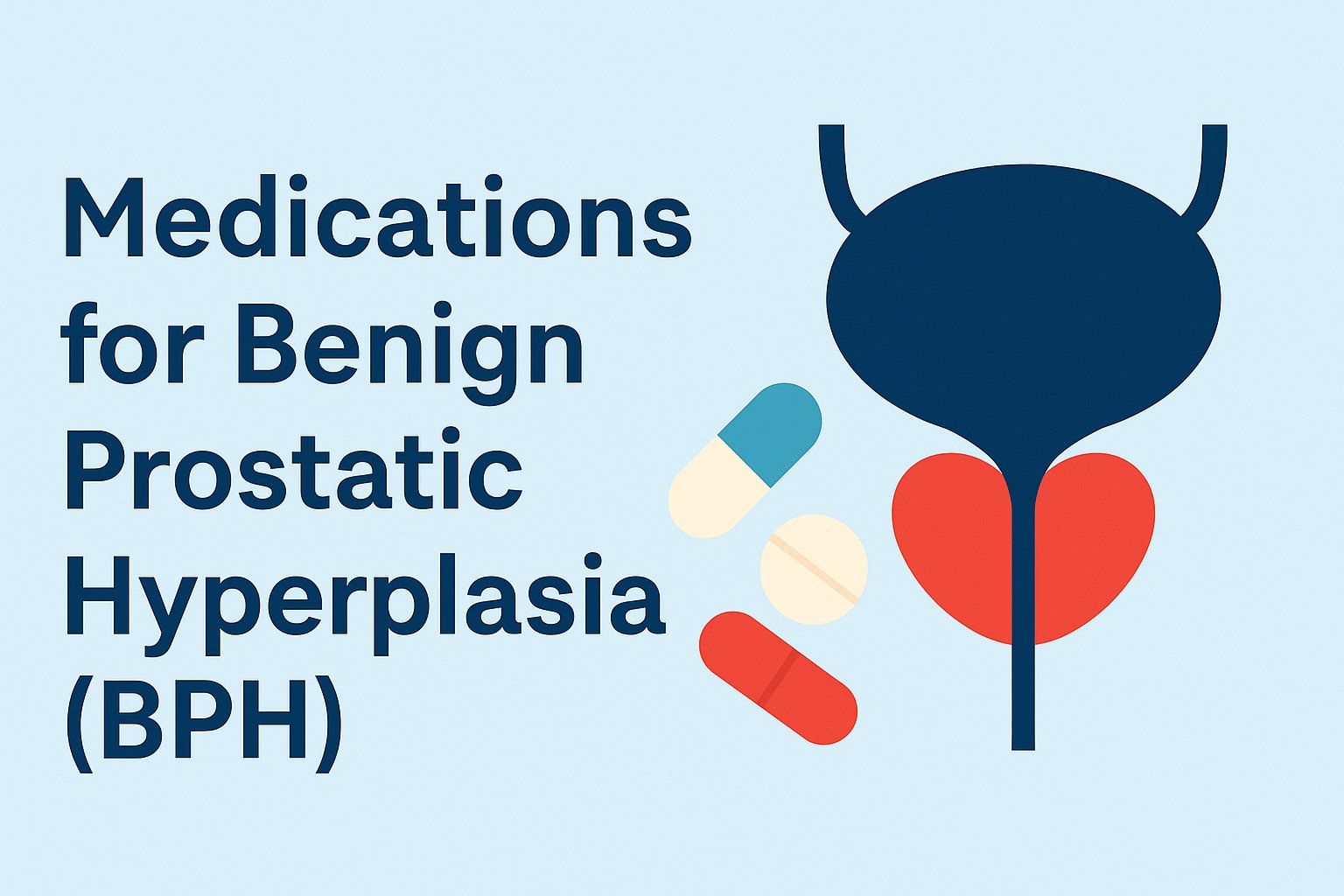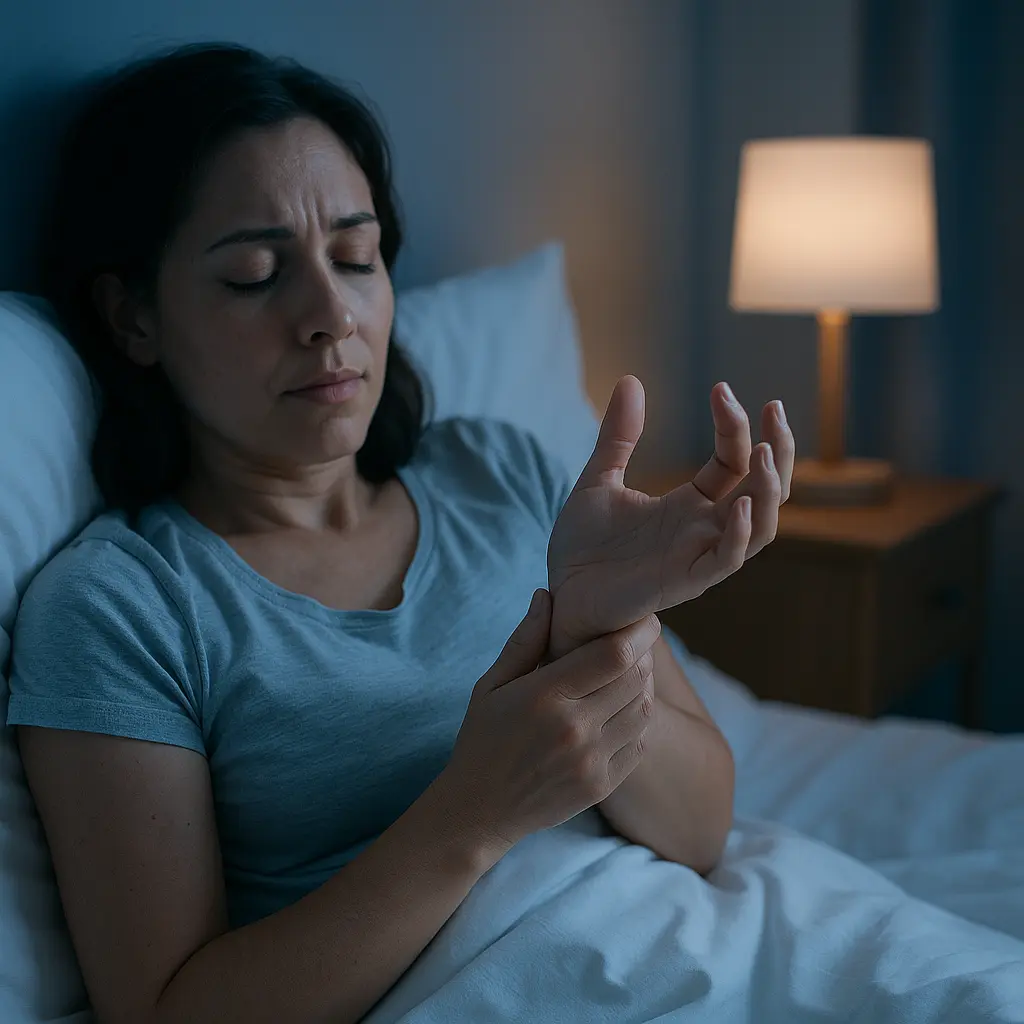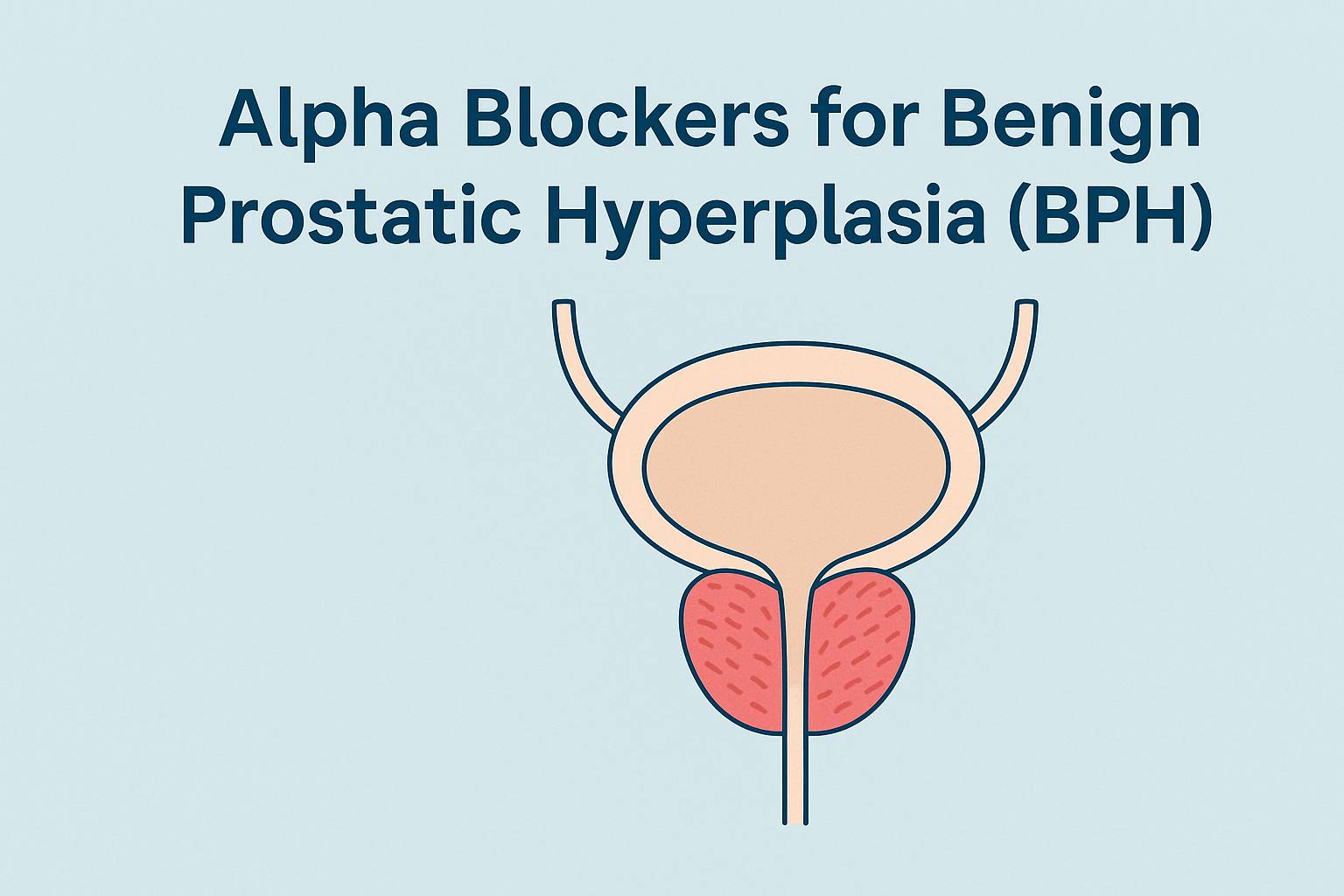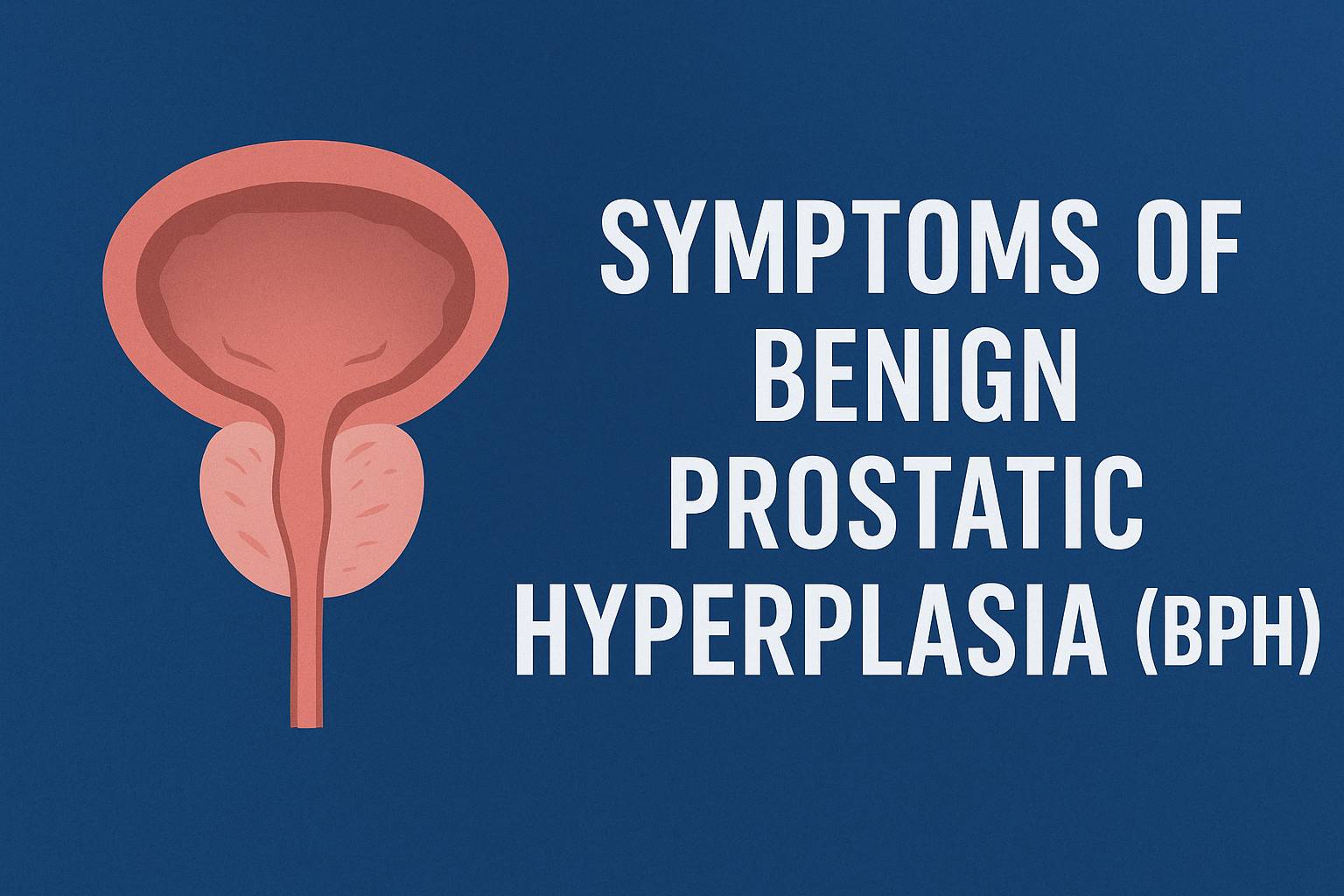Medications for Benign Prostatic Hyperplasia (BPH)
“In my clinical practice, I often see men who struggle with urinary symptoms caused by an enlarged prostate. Many worry that surgery is the only solution. In reality, benign prostatic hyperplasia medications can relieve symptoms, prevent complications, and improve daily life. In this guide, I explain how different drug therapies work, what to expect, and how doctors choose the right option for each patient.”
Living with benign prostatic hyperplasia (BPH) can affect both comfort and quality of life. Frequent urination, weak urine flow, and nighttime interruptions are more than minor inconveniences — they can disrupt sleep, work, and relationships. Fortunately, modern medicine offers several effective treatment options. Before surgery is considered, many men benefit from benign prostatic hyperplasia medications designed to ease symptoms and prevent complications. This article explores the main drug therapies for an enlarged prostate, how they work, and what patients can expect during treatment.
Why Medications Are Used for BPH
Drug therapy for enlarged prostate plays an important role in modern urology. While BPH is not life-threatening, its symptoms can significantly affect daily life. Medications allow many men to control these problems without immediate need for surgery, offering both relief and prevention of future complications.
Goals of drug therapy (symptom relief, preventing complications)
The primary goal of BPH medication is to reduce urinary symptoms such as frequent trips to the bathroom, weak stream, or the constant feeling of incomplete emptying. By improving the way the bladder and prostate interact, patients regain comfort and quality of life.
Another critical aim is preventing complications. Untreated obstruction may lead to urinary retention, bladder damage, or even kidney problems. Benign prostatic hyperplasia medications help lower these risks by keeping the urinary flow steady and reducing pressure on the bladder.
When doctors prescribe medications instead of surgery
Doctors usually recommend medication when symptoms are moderate but still disruptive. This approach offers patients a less invasive option that can stabilize the condition and delay or avoid the need for surgery.
Medication is also chosen when a patient’s overall health makes surgery risky. For example, older men with heart conditions or those on blood thinners often benefit from drug therapy as a safer alternative. In my own practice, I’ve seen many men improve with the right prostate medications, avoiding the stress of surgical intervention.
Medications for BPH and Drug Therapies for Enlarged Prostate
Drug therapy for enlarged prostate gives patients several treatment paths. Each option works differently, and doctors select the right one based on symptoms, prostate size, and overall health. Understanding the available choices helps men feel confident about their treatment plan.
Types of pharmaceutical treatments available
Doctors often prescribe alpha blockers, which relax the muscles around the prostate and bladder neck. These drugs bring quick relief, usually within days, by improving urine flow and reducing the feeling of incomplete emptying.
Another common group is 5-alpha-reductase inhibitors. These medications shrink the prostate over time by blocking the hormones that drive its growth. They work more slowly but provide lasting improvement, especially for men with larger prostates. In some cases, physicians combine both groups for greater effect.
How medications compare to other treatment methods
Compared to surgery, medications offer a less invasive option with fewer risks and faster recovery. Most men can continue their normal activities while starting benign prostatic hyperplasia medication, without the downtime of a procedure.
However, medications require patience and ongoing use. Unlike surgery, which removes or reduces prostate tissue, drug therapy manages symptoms over time. For many patients, this trade-off feels worthwhile, especially when symptoms remain moderate and stable.
Alpha Blockers: Relaxing the Prostate Muscles
Alpha blockers are one of the most common medications used to treat urinary problems caused by BPH. They act quickly, reduce discomfort, and allow patients to regain control over daily life.
How alpha blockers help in BPH
Alpha blockers relax the smooth muscles of the prostate and bladder neck. This action improves urine flow and decreases the constant urge to urinate. For many men, symptoms begin to ease within just a few days.
In clinical practice, alpha blockers benign prostatic hyperplasia treatment often works best for men with moderate symptoms and normal or slightly enlarged prostate size. They do not shrink the prostate but provide strong relief by improving muscle function.
Commonly prescribed alpha blockers (tamsulosin, alfuzosin, doxazosin)
Doctors frequently prescribe tamsulosin because it targets the urinary tract with fewer side effects. Alfuzosin is another option, often chosen for its consistent effect and good tolerance. Doxazosin, originally used for blood pressure, also helps improve urinary flow in men with BPH.
The choice depends on a patient’s overall health, other medications, and how well they respond to the first prescription. Adjustments are common until the right balance is found.
Side effects and considerations
Some men notice dizziness, lightheadedness, or low blood pressure, especially when standing up quickly. Others may experience changes in ejaculation or mild nasal congestion. These effects usually improve with time or dose adjustment.
Doctors monitor patients closely during the first weeks of therapy. If side effects remain troublesome, switching to a different alpha blocker often solves the problem without losing symptom control.
5-Alpha-Reductase Inhibitors
These benign prostatic hyperplasia medications target the hormone pathway that drives prostate growth. They help men with larger glands reduce symptoms and lower the risk of long-term complications.
Mechanism of action (reducing prostate size)
These drugs block the 5-alpha-reductase enzyme and cut the conversion of testosterone to DHT. Lower DHT levels shrink prostate tissue over time and ease the blockage at the bladder outlet.
Men usually feel benefits gradually. Symptoms improve over months, not days, so doctors often pair a 5-ARI with an alpha blocker for faster relief while the prostate slowly reduces in size.
Popular drugs (finasteride, dutasteride)
Doctors prescribe finasteride when they want targeted inhibition of the type II enzyme found in prostate tissue. It fits men with larger prostates and progressive symptoms.
They choose dutasteride when they want broader DHT suppression because it inhibits both type I and type II enzymes. Both medicines reduce PSA levels, so doctors adjust PSA interpretation during follow-up.
Possible side effects (sexual function, hormonal changes)
Some men report lower libido, erectile difficulties, or reduced semen volume. A small number notice breast tenderness or enlargement; rarely, mood changes occur. Side effects often ease after dose changes or discontinuation.
Doctors track PSA, symptom scores, and side effects at regular visits. They also warn families not to handle crushed tablets during pregnancy. If sexual side effects persist, doctors switch therapy or focus on alternative prostate medications.
Combination Therapies
Some men benefit most when doctors combine an alpha blocker with a 5-alpha-reductase inhibitor. This strategy gives both fast symptom relief and long-term reduction in prostate size.
When alpha blockers and 5-ARIs are prescribed together
Doctors use combination therapy for men with large prostates and significant symptoms. The alpha blocker relaxes muscles to improve flow within days, while the 5-ARI works over months to shrink the gland. Together, these medications cover both short- and long-term goals.
This approach suits patients who want quick relief but also need protection from future complications such as urinary retention or surgery.
Clinical effectiveness and patient outcomes
Studies show that men on combination therapy often experience stronger and more durable improvement than those on a single drug. They report fewer episodes of urinary blockage and a reduced need for surgical treatment.
In my practice, patients who commit to this regimen usually notice steady progress and fewer relapses. Symptom scores improve, and overall quality of life rises.
Cost and insurance coverage
Combination therapy usually costs more because it involves two prescriptions. Some patients face higher co-pays, especially if their insurance favors generic drugs.
However, many insurance plans cover both medications when doctors provide clear documentation of prostate size and symptom severity. For men without coverage, generics often lower the financial burden while maintaining the same clinical effect.
Other Medications Sometimes Used for BPH
Not every patient responds well to alpha blockers or 5-alpha-reductase inhibitors. In such cases, doctors sometimes turn to other prostate medications that target different pathways. These treatments are less common but can provide additional relief, especially for men with complex symptom patterns.
Phosphodiesterase-5 inhibitors (tadalafil)
Doctors prescribe tadalafil for men who want relief from urinary symptoms and also deal with erectile dysfunction. The drug enhances the nitric oxide–cGMP pathway and relaxes smooth muscle in the prostate, bladder neck, and pelvic vessels. Many men use a 5 mg once-daily dose and notice steadier flow, fewer nighttime trips, and better sexual function.
Tadalafil does not shrink the prostate, so it works best for symptom control rather than gland size reduction. Some men combine it with an alpha blocker for stronger relief; clinicians adjust timing and doses to reduce dizziness or blood pressure drops.
Avoid nitrates completely while taking tadalafil because the combo can trigger a dangerous fall in blood pressure. Use caution with strong CYP3A4 inhibitors, significant heart disease, or severe liver/kidney impairment. Common side effects include headache, flushing, back pain, nasal congestion, and dyspepsia; these usually improve with time or dose changes.
Anticholinergics and beta-3 agonists
Doctors use anticholinergics when bladder overactivity adds to BPH symptoms. These drugs calm bladder muscle contractions, which helps reduce urgency, frequency, and accidents. Patients with predominant storage symptoms often notice improvement within a few weeks.
Beta-3 agonists, such as mirabegron, activate receptors in the bladder wall and increase its capacity. They allow the bladder to hold more urine without sudden urges. Doctors sometimes combine them with an alpha blocker to address both voiding and storage issues at the same time.
Herbal and over-the-counter options (saw palmetto, supplements)
Many men try herbal remedies like saw palmetto before or alongside prescription treatments. Some studies show modest improvement in urinary flow or nighttime frequency, but results remain inconsistent. Supplements vary in purity and strength, so effects differ widely.
Doctors generally consider these options safe, but they stress the need for medical supervision. Herbal remedies should never replace proven benign prostatic hyperplasia medications, especially when symptoms are severe or complications develop. Patients who choose supplements should inform their physician to avoid drug interactions and missed diagnoses.
Choosing the Right Medication for BPH
Selecting the best treatment is never a one-size-fits-all decision. Doctors weigh several medical and personal factors before recommending specific benign prostatic hyperplasia medications. This process ensures therapy fits both the condition and the patient’s life.
Factors doctors consider (age, health, severity of symptoms)
Doctors first evaluate the patient’s age and overall health. Younger men with mild symptoms may need short-term medication, while older men with heart disease or other conditions often require safer, long-term solutions.
They also assess prostate size, urinary symptom severity, and risk of future complications. A man with a large gland and frequent retention episodes may benefit from a 5-alpha-reductase inhibitor, while another with moderate symptoms could start with an alpha blocker.
Patient lifestyle and preferences
Lifestyle plays a major role in treatment choice. A man who values sexual function may prefer tadalafil, while someone who travels often may need a once-daily pill with minimal side effects. Cost, insurance coverage, and comfort with possible side effects also guide the decision.
In practice, shared decision-making works best. Doctors explain the pros and cons, and patients choose a therapy that matches their priorities.
Monitoring treatment effectiveness
Doctors track progress through symptom questionnaires, flow tests, and follow-up visits. They also monitor PSA levels and watch for side effects. If the chosen drug does not provide enough relief, adjustments or combination therapy follow.
Patients should report changes promptly, whether positive or negative. Early feedback allows fine-tuning of prostate medications, keeping treatment safe and effective over time.
FAQ About BPH Medications
“As a physician, I know how frustrating urinary symptoms can be. Waking up several times at night, feeling constant urgency, or struggling with weak flow affects both health and quality of life. My advice is clear: do not ignore these signs. Modern BPH medications often provide strong relief and prevent complications. If symptoms continue or worsen, seek medical evaluation early. The sooner we act, the better the long-term outcome.”













